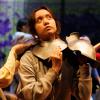
In the 12th-century Persian poem The Language of the Birds (also known as The Conference of the Birds), the parallels between birds and humans are obvious, says composer Sahba Aminikia, who has been in residency at the North Beach nonprofit arts organization 836M for the past five months, working on a multimedia adaptation of the poem. Now, Aminikia’s piece is set for its world premiere, May 31 – June 1 at 836M. (Both performances are currently listed as sold out.)
About 4,500 lines, The Language of the Birds is by the mystic Attar of Nishapur, a mentor of Rumi’s, whom Aminikia deeply admires. He loves what the poem says about unity.
“It tells the story of a large number of birds, and they represent humanity and us,” the composer says. “They have everything — they have beauty, they have power, but they’re deeply dissatisfied with something, and there is some sort of gap inside that they’re all trying to fill in.”
A prophet, a hoopoe, guides the other birds toward Simurgh, a legendary bird. At the end of the story, only 30 birds are left. The word for 30 birds in Farsi is, in fact, the name of that legendary bird.

“In the end, they realize the unification of these 30 birds that went through this spiritual process together creates that ultimate powerful creature,” Aminikia says. “We are living in a world that is so divided, and polarization is ravaging nations worldwide. Every morning, we wake up to pictures of children slaughtered in massacres all around the world. So I thought this would be a perfect time to do this [piece]. And it is always a perfect time for the unification of mankind, which, in my opinion, is only possible through spirituality.”
In that spirit of unification, Aminikia has brought in a host of collaborators for the piece, including The Living Earth Show, the San Francisco Girls Chorus, singer Marjan Vahdat, translator Zara Houshmand, and composer David Coulter — many of whom Aminikia knows well.
Valérie Sainte-Agathe, artistic director of the SF Girls Chorus, is a good friend, as are the musicians in The Living Earth Show, whom Aminikia knows from the San Francisco Conservatory of Music. In Dallas, he and Houshmand did a project on Rumi, and Aminikia has also worked with Coulter before and calls him “a master of improvisation.”
One person Aminikia hadn’t collaborated with until now was media artist John Sanborn, also a friend, who did the visuals for the piece. “He has this very bold and courageous character,” Aminikia says. “I wanted him to dive into this story and see what he could create.”
This year’s theme at 836M has been “Beyond Frontiers,” says Céline Ricci, the organization’s programming director. Ricci says The Language of the Birds and its spirit of collaboration fit perfectly with that.
“It shows the diversity of San Francisco — not only the diversity in nationalities but also in age and in art forms,” she says. “This is a multimedia work, and I’m really glad that we can assemble all these different artists to show the importance of music not only as music but also as a vehicle for bringing together different forms of art.”
The residency has been a wonderful experience, Aminikia says. Not only did he get space to work, but that space was decorated to his taste, with a Persian rug, miniature paintings, and a piano.

The performances on May 31 and June 1 will start with a parade of children. Having children in his work is important to him, Aminikia says, and he looks forward to it.
“The children will shout, ‘Praise, praise the creator, the perfect creator.’ In this day and age, that is a radical act in San Francisco, and I wanted that sense of shock that the audience will experience and this sense of togetherness. This piece is about unification, not about dividing people, and it’s about bringing East and West together. It was expected from me, honestly, to bring in a bunch of Middle Eastern musicians as my collaborators in this project. But I intentionally brought the people that I have the most heartfelt connection with, and I wanted them to be involved in this.”
Ultimately, Aminikia hopes to get rid of boundaries with his work. “Just bringing all these beautiful people [together] with the children of San Francisco, who are divine in my opinion. I want to experience this sense of togetherness. I look forward to that because right now, what we see on the news every day — it’s so dividing and so heartbreaking. I need to experience this. We need more of this — coming together and creating something together and enjoying something together.”




